The C-RED range offers a wide selection of InGaAs-based cameras for laser beam profiling, ranging from 0.9 µm up to 2.2 µm. In this paper, we demonstrate high-speed laser beam profiling to study the effect of atmospheric turbulence on a laser beam’s power distribution. Real-time image processing features included in First Light Vision software are used to monitor the laser beam profile.
1. INSIGHTS INTO LASER BEAM PROFILING
Laser technology has made great progress over the past 50 years. Its multiple applications have made it essential in everyday life: science, telecoms, medicine, and industry. Depending on the use case, different types of lasers may be used. For example, Nd:YAG lasers emit at 1064 nm and are widely used in scientific experiments (spectroscopy, ophthalmology, metal engraving, etc). 1550 nm lasers are increasingly popular for free space laser communications and tracking, while laser diodes in the range 2000 – 2500 nm have applications in medical systems.
Laser beam profiling is a technique used to measure and analyze the spatial characteristics of a laser beam. It provides information on intensity distribution, shape, and size. It has multiple applications, among which:

- Monitoring laser quality. As lasers may degrade over time, it is important to monitor their performance. This can include measuring spatial intensity distribution and temporal stability.
- Laser beam R&D. Profilers can be used to gain a better understanding of laser physics and adjust laser parameters for optimal beam shaping (g., to achieve a top-hat or line beam profile).
- Application. Study the temporal evolution of a beam, for example to assess the impact of environmental parameters (temperature, wind, snow, ) on the propagation of a laser beam.
Figure 1 – Typical top-hat laser power distribution. Acquisition with a C-RED 3 camera.
With the advent of laser-based communication schemes, time-resolved laser beam profiling is increasingly popular. It is critical to have an imaging system able to keep up with the typical time scale of the fluctuations. Similarly, pulsed laser beam analysis also requires the ability to achieve high frame rates and low image lag.

Figure 2 – Time-lapse screenshots showing the temporal fluctuations of a laser beam when temperature variations are induced in the propagation path. Acquisition with a C-RED 3 camera, at 600 Hz.
|
High-speed SWIR cameras from First Light Imaging can be used to monitor |
2. WHY USE A C-RED CAMERA ?
First Light Imaging offers a full range of high speed SWIR cameras based on InGaAs sensors. The sensors are back-illuminated which enables to reach a fill factor of 100%, and feature a CTIA (Charge TransImpedance Amplifier) readout technology for a linear response. All cameras feature USB 3.1 and/or CameraLink communication interfaces. Additional key features:
- High speed. All C-RED cameras can run at 600 FPS in full frame mode (640 x 512 pixels) and up to 32,000 FPS in a 32 x 4 pixels window, enabling time-resolved laser beam profiling.
- Variable integration time. The integration time can be tuned down to 10 µs. For short laser pulse duration, an optimized “short-exposure” mode enables reaching integration times down to 165 ns*.
- Flexible synchronization. An externally generated trigger pulse can be used to trigger both the laser and the camera. Alternatively, the camera output synchronization signal can be used to trigger the laser. Such a scheme allows to avoid introducing a jitter.
- Easy integration. The cameras can be easily integrated in your system thanks to interface positioning and threaded holes and a C-Mount/CS-Mount optical interface. All cameras are supported by our multi-camera software First Light Vision and versatile SDK (MatLab, LabView, Python, etc.)
- Small beam size. The sensor’s 15 µm pixel pitch allows the profiling of small beams and acquisition of additional beam details (if the laser points directly at the camera**). With a sensor active area of 9.6 mm by 7.68 mm the recommended beam diameter ranges from 150 µm to 6 mm.
Three high speed SWIR cameras are especially relevant for laser beam profiling:
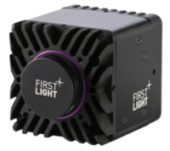
C-RED 3: windowless customization
In the case of direct incidence of the laser beam on the sensor, interference fringes tend to degrade the measurement quality. First Light Imaging can provide the C-RED 3 camera with a window-less detector to avoid interference fringes. It is also possible for the user to place a custom window coated specifically for the wavelength of use.
C-RED 2 Lite: quantitative measurements
The ThermoElectric Cooling (TEC) integrated in the camera ensures perfect stabilization of the camera performance over extended periods of time. Thanks to this feature, the camera can be used for quantitative measurements, such as power monitoring in laser beam profiling. The C-RED 2 Lite camera is provided with a Sapphire window with an anti-reflective coating.
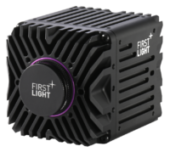
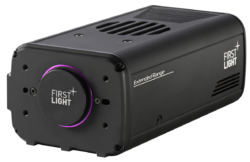
C-RED 2 Extended Range: for 2.05 µm lasers
Standard InGaAs sensors have a cutoff wavelength at 1700 nm. To address the need to profile lasers beyond this wavelength, First Light Imaging has developed two extended SWIR cameras: the C-RED 2 ER 1.9µm and the C-RED 2 ER 2.2µm, which enable to detect wavelengths up to 1900 nm and 2200 nm, respectively.
|
To see the full range of high speed low noise C-RED cameras, please visit our page “product“! |
* The camera performances may be altered below 10 µs. Please contact support@first-light.fr for more information.
** Pointing a laser directly onto the sensor should only be replicated with caution. High energy sources can have unwanted effects on the sensor. First Light Imaging cannot disclose the maximum power that a camera can handle.
3. USE CASE
Laser beam profiling set-ups can vary in design. Here, we showcase the performance of a camera-based profiler integrating the high speed SWIR C-RED 3 camera. The imaging system consists of the camera and a SWIR optimized objective lens with a focal length of 100 mm. This system is part of an optical bench dedicated to free space optical communication research and development. The optical bench allows us to simulate the fluctuations of a SWIR laser as it propagates through the atmosphere. To achieve this, temperature variations are induced in a ceramic plate where the laser is incident. The profiler is used to monitor the beam profile in real-time.
Experimental set-up
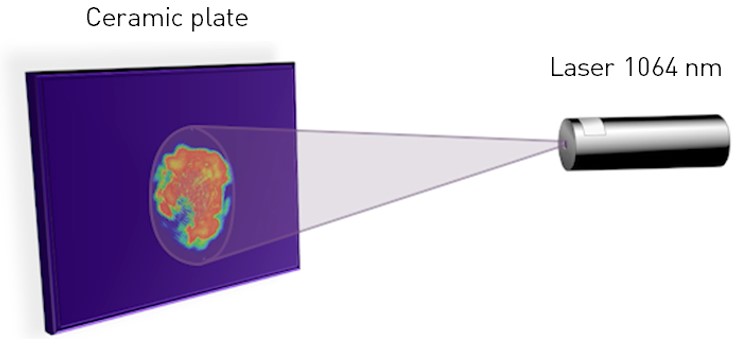
Figure 3 – Laser beam profiling experiment.
In the experiment, a solid-state continuous laser at 1064 nm is directed onto a ceramic plate. A C-RED 3 camera is positioned adjacent to the laser to capture images of the plate.
To simulate atmospheric turbulence, the ceramic plate is heated, introducing fluctuations in the laser beam. Additional movement can be induced by incorporating a tip-tilt mirror into the laser beam path.
Real-time image processing
The First Light Vision software is used for direct visualization and to perform basic image processing operations. In the display panel, it is possible to visualize in real-time:
- 2-D power distribution
- Spatial and temporal statistics (mean value, standard deviation, etc)
- Plots of multiple line profiles and cross-sections
- Area histograms
The data can be saved in *.raw format at full speed on the computer hard drive via the “Record” feature, for subsequent off-line image processing.
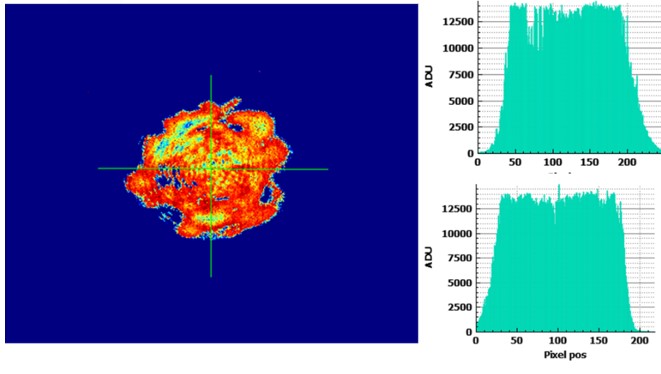
Figure 4 – Laser beam image and cross-section profile.
Going further…
With custom software development based on the Software Development Kit, specific laser beam processing can be implemented. Typical measurements include 2D beam diameter (1/2, 1/e, 1/e2), edge steepness, beam divergence, beam quality, and laser pointing stability.
4. CONCLUSION
Camera-based laser beam profiling is a valuable tool for analyzing the spatial characteristics of laser beams, providing crucial insights for numerous applications.
Through a use case illustration, we have explored the significance of capturing real-time data to ensure accurate and comprehensive beam analysis. The experimental set-up allows to simulate atmospheric fluctuations and monitor their effect on laser beam stability and spatial distribution. Such set-ups may be used to test new adaptive optics schemes, which will aim to correct for the induced distortions. The application is gaining popularity as laser-based communication programs continue to grow.
Time-resolved laser beam profiling, enabled by the integration of a high-speed, low noise camera, offers a dynamic perspective on laser behavior. This capability allows researchers and engineers to understand the temporal variations in the beam’s intensity distribution, enabling deeper insights into pulsed and transient laser operations. By leveraging a high speed camera, one can effectively capture the rapid changes and fluctuations in the beam profiling. The dynamic data provided by First Light Imaging cameras empowers the user to fine-tune laser systems, ensure precise alignment, and optimizing laser-based system performance for various applications.
|
– Wavelength coverage: from 900 nm to 2200 nm – Sensor thermalization: uncooled, stabilized or cooled – High speed: up to 600 frames per second – Low noise: 30 – 50 electrons readout noise |
For more application ideas, check out our FOCUS ON… series!
FOCUS ON… Wavefront Sensing & Adaptive Optics
FOCUS ON… Free Space Optical communications
FOCUS ON… Monitoring weld deposition, etc !

Thank you to our partner OptoScience for providing the images!
For more information (or to share your images!), please contact First Light Imaging at:
contact@first-light.fr
www.first-light-imaging.com


